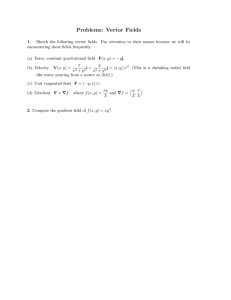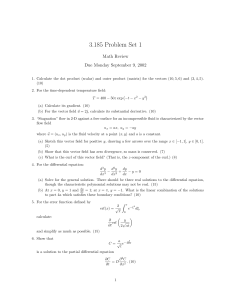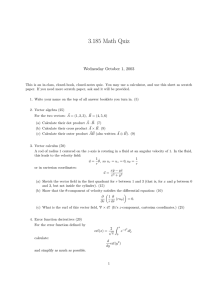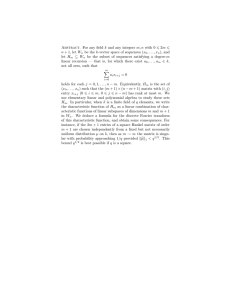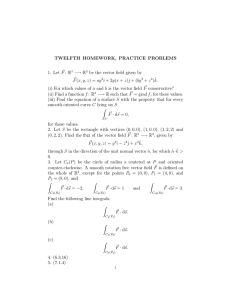Unit 2 Coulomb`s Law and Electric Field Intensity
advertisement
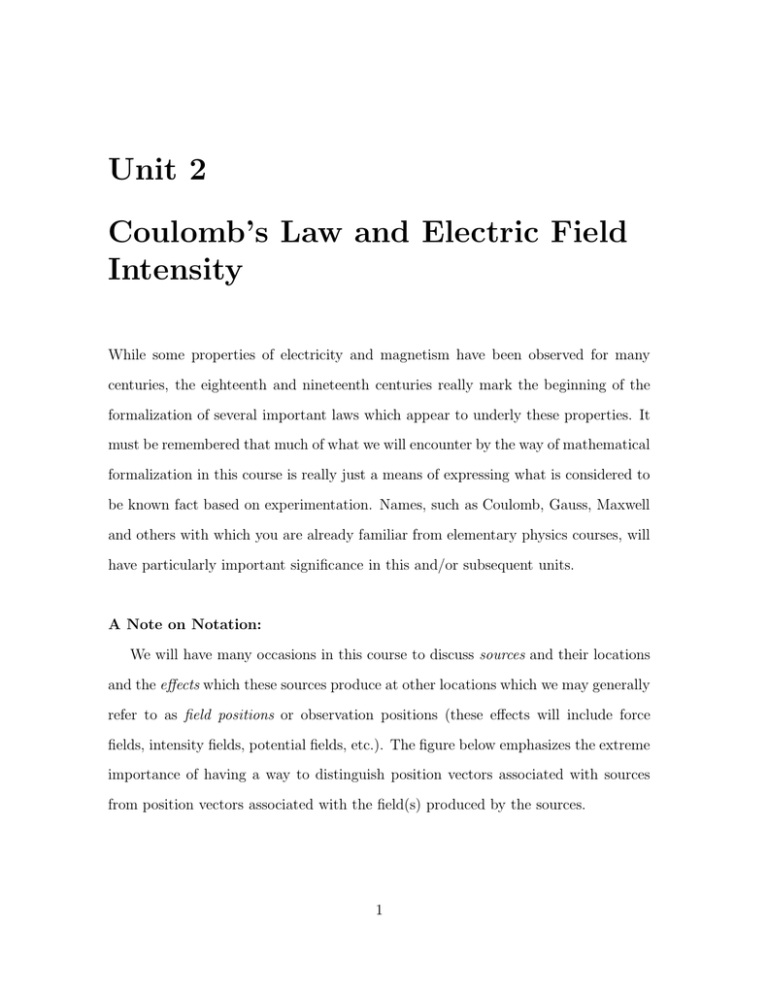
Unit 2 Coulomb’s Law and Electric Field Intensity While some properties of electricity and magnetism have been observed for many centuries, the eighteenth and nineteenth centuries really mark the beginning of the formalization of several important laws which appear to underly these properties. It must be remembered that much of what we will encounter by the way of mathematical formalization in this course is really just a means of expressing what is considered to be known fact based on experimentation. Names, such as Coulomb, Gauss, Maxwell and others with which you are already familiar from elementary physics courses, will have particularly important significance in this and/or subsequent units. A Note on Notation: We will have many occasions in this course to discuss sources and their locations and the effects which these sources produce at other locations which we may generally refer to as field positions or observation positions (these effects will include force fields, intensity fields, potential fields, etc.). The figure below emphasizes the extreme importance of having a way to distinguish position vectors associated with sources from position vectors associated with the field(s) produced by the sources. 1 z Source Region r' r - r' = R In this course, the source region may P(x,y,z) Field or Observation Position r consist of charges or currents. Generally, the positions of points within this region y will labelled using “primed” coordinates x as indicated by r here. The positions at which the effects of these sources are measured will be indicated by unprimed coordinates, such as r here. The vector from the source to the observation or field position as R̂. is then clearly r − r . We will indicate the unit vector in the direction of R Also, R = |r − r |. 2.1 Coulomb’s Law In the 1785, Charles Coulomb established that the fundamental law of electric force between two particles having charges of Q1 and Q1 possessed the following properties: 1. the magnitude of the force is proportional to the product of the magnitudes of the charges (i.e. F ∝ Q1 Q2 ); 2. the magnitude of the force is inversely proportional to the the square of the distance R between the charges (i.e. F ∝ 1/R2 ); 3. the direction of the of the force is along a line joining the charges – this is because point charges can exert forces only radially; 4. the force is attractive if the charges are opposite in sign and repulsive if the charges have the same sign. Putting all of this together we have F ∝ Q1 Q2 R2 2 which implies that, using k as the proportionality constant and using SI units for which force is measured in newtons (N), charge in coulombs (C) and distance in metres (m), the magnitude of F is F =k Q1 Q2 R2 (2.1) where k= with being called the permittivity of the region in which the charges exist. This parameter has units of farads per metre (F/m), the farad being the unit of capacitance. For the special case of free space we subscript the permittivity with a 0 and its value becomes 0 = 8.854 × 10−12 F/m ≈ 10−9 F/m . 36π The Vector Form of Coulomb’s Law: Consider properties (3) and (4) above in association with the following diagram in which charges Q1 and Q2 are located at positions r1 and r2 , respectively, from some origin O: 12 and in view of equation (2.1) We label the displacement vector from Q1 to Q2 as R and the properties indicated, the force which Q1 exerts on Q2 is F12 = (2.2) 12 . Explicitly, where R̂12 is the unit vector in the direction of R R̂12 = (2.3) 3 which means that equation (2.2) may be written as Q1 Q2 r2 − r1 F12 = 4π |r2 − r1 |3 (2.4) Of course, from Newton’s third law of motion, the force which Q2 exerts on Q1 – i.e. F21 – is equal in magnitude but opposite in direction to that which Q1 exerts on Q2 . That is, Q1 Q2 R̂21 F21 = −F12 = 2 4πR21 (2.5) with R̂21 = −R̂12 = r1 − r2 . |r1 − r2 | Force on a Charge Due to Multiple Charges: Next, suppose that a total of n charges exist in a region. We may label them Q1 , Q2 , . . . Qn as shown: Next, the displacement vector from the mth charge, Qm , to Q1 may be defined as m1 with a corresponding unit vector R̂m1 . Then the total force, FT , on Q1 due to the R other n − 1 charges is simply the vector sum of the forces exerted by the individual charges. That is, FT = n Q1 Qm R̂m1 2 m=2 4πRm1 (2.6) EXAMPLE: Four 10 μC charges are located in free space at (−3, 0, 0), (3, 0, 0), (0, −3, 0), and (0, 3, 0) in the cartesian coordinate system. Find the force on a 20 μC charge located at (0, 0, 4). 4 2.2 2.2.1 Electric Field Intensity Due to Point Sources Electric Field Due to a Single Point Charge at a point in space due to a source is By definition, the electric field intensity, E, the force per unit charge experienced by a positive test charge, Qt , brought to that point. Suppose, for example that the source is a point charge Q1 . See illustration below: In this case, from equation (2.2), on letting Q2 = Qt , the force experienced by the test charge due to source Q1 would be Q1 Qt F1t = R̂1t , 2 4πR1t (2.7) we and the direction is along the line from Q1 to Qt . Then, from the definition, E have = F1t = Q1 R̂1t . E 2 Qt 4πR1t (2.8) Notice that the electric field intensity does not depend on the test charge. Therefore, it is convenient to drop the t subscripts along with the 1 subscript, since there is only one charge here (i.e. we may as well call the single charge Q) and write = E Q R̂ 4πR2 (2.9) where R̂ points from Q to the position where we are considering the test charge to be or, in other words, the position at which the field is being measured. If Q is at the origin of the spherical cordinate system, it also makes sense to simply use r instead as a force per charge, the units must be of R. We note that from the definiton of E 5 newtons/coulomb (N/C). However, you have seen in earlier courses that a joule (J) is a newton·metre which makes the newton a joule/metre. Thus, N/C = (J/m)/C = and since as you know (and as we will see again in this course) the (J/C) is named the volt, it makes good sense to use units of V/m for the electric field intensity. To help with a discussion of more complicated cases than the field due to a single point charge, we may formalize equation (2.9) in terms of the diagram on page 2 of this unit. Consider that the charge Q is at position r – i.e. at the source position – at the field or observation position r. and that we wish to measure the field E = R = |r − r | and, as = r − r , as shown. In terms of magnitudes, |R| Clearly, R before, R̂ = R r − r , = |r − r | |R| so that equation (2.9) may be written in general form as r ) = Q(r − r ) . E( 4π|r − r |3 (2.10) explicitly as E( r ) to emphasize that the electric field intensity We have written E depends on the position at which it is measured. 2.2.2 Electric Field Due to Multiple Point Charges If several point charges are responsible for the electric field intensity at a partical position in space, the total field is simply the vector sum of the individual fields from each of the charges. Consider the following illustration while keeping an eye on equation (2.10): 6 r), we have for the n charges Symbolizing the total field at position r as E( r) = E 1 (r) + E 2 (r) + · · · + E n (r) . E( (2.11) Now instead of writing primed vectors for the positions of the individual sources (charges), we may replace the r for Q1 , Q2 , . . . , Qn by r1 , r2 , . . . rn , respectively. From equation (2.10), which gives the contribution to the field for one charge, and equation (2.11) which tells us how each charge contributes to the total field, we may immediately write r) = Q1 (r − r1 ) + Q2 (r − r2 ) + · · · + Qn (r − rn ) E( 4π|r − r1 |3 4π|r − r2 |3 4π|r − rn |3 (2.12) or r) = E( n Qm (r − rm ) . r − rm |3 m=1 4π| (2.13) EXAMPLE: Four 10 μC charges are located in free space at (−3, 0, 0), (3, 0, 0), (0, −3, 0), and (0, 3, 0) in the cartesian coordinate system. Find the electric field intensity at position (0, 0, 4). (See problem on page 4 of this unit.) 7 2.3 2.3.1 Electric Field Intensity Due to Continuous Charge Distributions Continuous Charge Distributions When the charges are not discrete entities, but rather continuous in nature, it should come as no suprise that the effects of all the differential pieces of the charges must be summed – i.e. integrated – in order to find the total field effect. Before calculating the electric field intensities from such sources, however, it may be worthwhile to consider the sources themselves. Continuous line sources: Suppose that a line of charges has a constant density ρL (with units of C/m). Then in a distance along the line, since by definition the constant density is given by ρL = charge along , the charge Q is simply Q = ρL . Next, suppose that the charge density is a function of the position along the line. To help with the discussion, let’s suppose the charge is along the z axis and the charge density is a function of the position on the axis. Since this is a source we use ρL (z ) as the symbol for the charge density – in general the symbol would be ρL (r ). Now, by definition, an incremental length Δz will contain an incremental charge ΔQ. Then in keeping with our knowledge of limits, we may write that at any position z , ΔQ = Δz →0 Δz ρL (z ) = lim Thus, integrating gives dQ = and over a length Q= ρL (z )dz , ρL (z )dz 8 (2.14) It is common practice to drop the argument from the density expression and simply use Q= ρL dz , (2.15) but it is important to realize that sometimes ρL will not be constant over the integration path. Example: Determine the total charge from y = 2 to y = 4 for a charge density along the y axis given as ρL = e−|y | . Continuous volume sources: In equation (2.14), the charge density may change incrementally along a line. Suppose the charge density changed incrementally through a small volume, Δv located at position r . In this case, we speak of a volume charge density ρv (with units of C/m3 ) defined by ΔQ = Δv→0 Δv ρv (r ) = lim and (2.14) is replaced by Q= vol ρv dv , (2.16) where for the time being we have dropped the r argument in the ρv function. Since this is a volume integral vol is, of course, a triple integral. Example: Determine the total charge in the region 0 ≤ x , y , z ≤ 2 for a volume charge density given as ρv = x y z . 9 Continuous surface sources: Finally, suppose the charge density existed continuously over a surface. For this case, the charge density will be a surface charge density, ρS (with units of C/m2 ), where again we have dropped the r argument. This time, the integration, analogous to that in equation (2.14), will be over the surface (in general a double integral) and is given by Q= S ρS dS , (2.17) Example: Determine the total charge in the region 0 ≤ ρ ≤ 2, 0 ≤ φ ≤ π/2 for a surface charge density given as ρS = sin φ . 10 2.3.2 Electric Field Intensity of a Continuous Line Source Consider a line of charges having a uniform charge density ρL along the z-axis in free space as shown below.: In considering many electromagnetics problems, a good deal of work can be circumvented by first considering the the following two questions: (1) are there any coordinates with which the field does not vary? or equivalently, what are the coordinates with which the field does vary?; (2) which components of the field are not present? or equivalently, which components of the field are present? With respect to the figure above, we address question (1): We readily note that for a fixed ρ and z, the line charge “looks” the same no matter what the value of angle φ. for this charge configuration We say that there is azimuthal symmetry present and E does not depend on φ. Next, we note that if we fix ρ and φ and move up and down in the z direction, at any position z recedes to infinity in both positive and negative directions, and the problem does not change with this position – i.e. there is axial symmetry. Thus, for this case, the E-field is not a function of z. However, if we fix φ and z and change ρ (i.e. increase or decrease the distance from the source) Coulomb’s with ρ. In summary, then , the answer law might lead us to expect a variation in E to question (1) is that the field varies only with ρ. 11 Again, with respect to the figure, let’s consider question (2): Since a differential amount of charge dQ produces only radial field components, there can be no φ̂ component. Of the remaining components, we note that at any particular position the ẑ components will cancel due to the fields caused by charge elements equidistant above field and in and below that position. Thus, only the ρ̂ components survive for the E view of our answer to question (1), that component should be a function of ρ only. As we set up and complete the problem, some of the above features will become obvious from the math. From equation (2.14) and what precedes it, we see that a differential amount of charge is given by dQ = ρL dz . Writing This dQ gives rise to a differential amount of electric field intensity dE. equation (2.10) using these differential quantities, we have r) = dE( dQ(r − r ) = 4π0 |r − r |3 (2.18) Since the field does not vary with φ or z, without loss of genrality, we may choose a point on the y axis at which to calculate the form of the field due to dQ. We note then that r = z ẑ and r = y ŷ = ρρ̂ so that r − r = . Therefore, (on dropping the argument for compactness) = dE We have already discussed that the ẑ component will not be present in the field expression here (this could also be explicitly determined by doing a complete inte expression). Given this fact, we need only determine the ρ̂ gration on the above dE 12 component of the field intensity by considering dEρ = which means that Eρ = ∞ −∞ ρL ρdz 4π0 ρ2 + z2 3/2 . This may not be an immediately-recognizable integral. Tables may be used to determine the answer as or in vector form we have E(ρ) = ρL ρ̂ . 2π0 ρ (2.19) Other approaches to the integration may also be used. Pay close attention to pages 40 and 41 of the text. We note that equation (2.19) reveals that, unlike Coulomb’s field of an infinite line charge with uniform density law for the point charge, the E IS NOT an inverse square relationship. Rather E ∝ (1/ρ). It is also worthwhile to consider the effect on equation (2.19) if the line is not on the z axis (see text page 41). 13 2.3.3 Electric Field Intensity of a Sheet of Charge Strip transmission lines (eg., traces on a printed circuit board) or parallel plate capacitors are two common electrical elements which basically consist of ‘sheets’ of charge. In these cases, surface charge density, ρS , will be an important feature. As a basic approach to what sometimes may become very difficult problems involving surface charge densities, in this subsection we consider the idealized case of a infinite sheet of charge existing in one of the coordinate planes in free space. Let’s seek to determine the field produced by a positive uniform surface charge density, ρS , existing in the entire x = 0 plane – i.e. in the yz plane: r = Illustration: r = = R R̂ = dS = It should not surprise us that the field cannot be a function of y or z because for ANY point we pick to observe the field, there is an infinite charge in both y and z directions. Furthermore, the y components will cancel and the z components will cancel (this is clear from symmetry). From these observations, we don’t lose generality by choosing a point on the x-axis at which to evaluate the field. This, of course may also be revealed from the mathematics, if we seek to set up the problem as below. Now, in equation (2.18), dQ = ρS dS so using the above quantities (and suppressing the argument in the E-field) r) = dE( dQ(r − r ) = 4π0 |r − r |3 and integrating gives = E (2.20) 14 Equation (2.20) may be written and evaluated component by component: ∞ ∞ xdy dz + ŷ z =−∞ y =−∞ (x2 + y 2 + z 2 )3/2 ∞ ∞ −z dy dz +ẑ z =−∞ y =−∞ (x2 + y 2 + z 2 )3/2 = ρS x̂ E 4π0 ∞ z =−∞ ∞ y =−∞ −y dy dz + (x2 + y 2 + z 2 )3/2 (2.21) Remember that as each integral is executed, only the variable associated with the differential is actually ‘variable’ – for example, as the dy integral is completed the x and z are considered constants and similarly as the dz integral is completed the x and y are considered constants. Before evaluating (2.21), we note that Thus the dy integral in the ŷ component and the dz integral in the ẑ component integrate to 0 and both of these components therefore become 0. This leaves us with only the x̂ component: ∞ = ρS x̂ E 4π0 ∞ z =−∞ y =−∞ xdy dz (x2 + y 2 + z 2 )3/2 . This integral is NOT VERY NICE! We may use tables or software to determine it. Mathematica gives ∞ z =−∞ ∞ y =−∞ xdy dz = 2π (x2 + y 2 + z 2 )3/2 which means that = ρS x̂(2π) E 4π0 or = x̂ ρS E 20 (2.22) Amazingly (perhaps), this result does not depend on the distance from the sheet of charge. Furthermore, the field is normal to the charge sheet. That is, in general, = n̂ ρS E 20 15 (2.23) where n̂ is a unit normal to the sheet pointing outward from the sheet. Thus, had we chosen a field point on the negative x-axis (or anywhere in the x < 0 halfspace), the answer would be = −x̂ ρS E 20 (2.24) Example: Parallel Plate Capacitor Suppose a second sheet of charge parallel to that above having a negative charge density −ρS is located at x = a. If we use subscript + for the field from the positive ρS and subscript − for the field from the negative ρS , we have: Region x > a: Region x < 0: Region 0 < x < a: + = x̂ ρS and E − = x̂ ρS so that E 20 20 =E + + E − = x̂ ρS + x̂ ρS = x̂ ρS E 20 20 0 (2.25) which is precisely the field between the plates of a parallel plate capacitor whose dielectric is free space (or to a good approximation air), provided the plate separation is small compared to the plate dimensions and the field point is well away from the edges (in reality there may be some so-called fringing at the edges so that outside the capacitor the field may be not be exactly zero as calculated above for the infinite sheets – still, in real life, the fields outside the capacitor can usually be considered to be negligible). 16 2.3.4 Electric Field Intensity of a Volume Charge Consider, next, a volume charge density ρv in a region of space. From equation (2.16) we see that a differential amount of charge dQ is given by dQ = ρv dv . Note the following illustration: Using the above expression for dQ in the first equality of equation (2.18) gives the differential contribution to the electric field intensity as r) = dE( ρv dv (r − r ) dQ(r − r ) = . 4π0 |r − r |3 4π0 |r − r |3 Integrating both sides of this expression gives r) = E( ρv dv (r − r ) r − r |3 vol 4π0 | (2.26) This integral is usually very nasty and often cannot be completed in closed form. 17 2.4 Streamlines – Visualizing the Electric Field Read Section 4.6 of the text. The visualization of electric fields for all but the simplest charge configurations is indeed a difficult process. However, this process of visualization may be aided if we are content to look at only the direction of the field in specific planes, rather than in three dimensions. The result is a set of continuous lines referred to as streamlines (or flux lines, or field lines etc.) for which the field is everywhere tangent to the lines. As contour lines on a map also indicate steepness so the magnitude of the electric field is inversely proportional to the spacing of streamlines. As a first example, consider the streamlines for a point charge Q as shown below. We know that the direction of the field is radial from the charge so the streamlines will also be radial: We note that for line 1, y = 0, for line 2, y = x, for line 3, x = 0, for line 4, y = −x. That is, in all cases, y = Cx where C is 0, 1, and -1 for lines 1, 2, and 4 respectively, and for line 3, 1/C = 0. More generally it may be noted that since the field is tangent to a streamline, from similar triangles it is easily seen that in the limit, we have Δy Ey = lim Ex Δx→0 Δx or dy Ey = . Ex dx 18 (2.27) Thus, if the functional forms of Ex and Ey are known, we may solve the differential equation to obtain y in terms of x – i.e. we may find the streamline equations. In general, the solution will be a family of such ‘lines’ (which of course are not necessarly ‘lines’ in the mathematical sense, since they could be any curved path). Example: Exercise D2.7 (b) from text: Find the equation of the streamline that passes through the point P (1, 4, −2) in the field = 2e5x [y(5x + 1)x̂ + xŷ] . E 19
